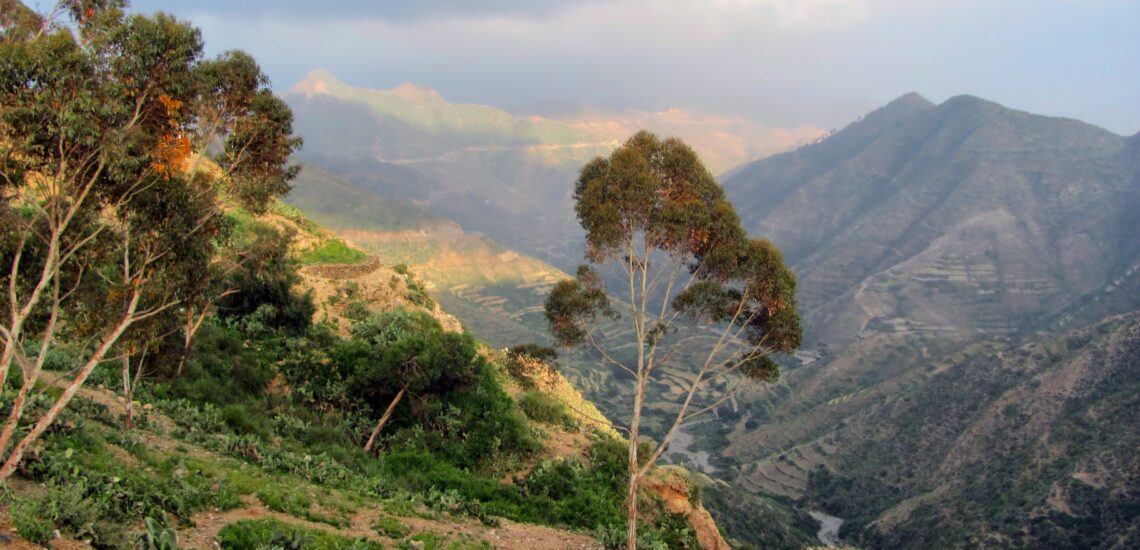Datos breves sobre Eritrea:
- Población: aproximadamente 6 millones de personas.
- Capital: Asmara.
- Idiomas oficiales: tigriña, árabe e inglés.
- Otros idiomas: Se hablan varios idiomas indígenas, incluidos Tigre, Bilen y Kunama.
- Moneda: Nakfa eritreo (ERN).
- Gobierno: república presidencial unipartidista unitaria.
- Religión principal: el cristianismo (principalmente el cristianismo ortodoxo eritreo), con una importante cantidad de musulmanes y una pequeña minoría de otros grupos religiosos.
- Geografía: Ubicado en el Cuerno de África, limita con Sudán al oeste, Etiopía al sur, Yibuti al sureste y el Mar Rojo al este.
Dato 1: Eritrea es un paraíso para los arqueólogos
Uno de los sitios arqueológicos más importantes de Eritrea es Qohaito, una ciudad antigua que se remonta a la era precristiana. El sitio cuenta con impresionantes ruinas que incluyen tumbas excavadas en la roca, inscripciones y edificios antiguos, que proporcionan información valiosa sobre la historia temprana y las conexiones comerciales de la región.
La región de Nabta Playa, aunque se asocia principalmente con Egipto, se extiende hasta Eritrea y es conocida por su arte rupestre prehistórico y sus hallazgos arqueológicos. Esta área ofrece una visión de los primeros asentamientos humanos y sus interacciones con el entorno circundante.
Además, la antigua ciudad portuaria de Adulis, en Eritrea, fue un importante centro comercial en la antigüedad, ya que unía el Mar Rojo con el interior de África. Las ruinas de Adulis, que incluyen restos de arquitectura romana y aksumita, destacan su importancia histórica como centro comercial clave.
La región de Keren, conocida por su arquitectura de la era otomana bien conservada, y la zona de Asmara, con sus edificios coloniales italianos, contribuyen aún más a la riqueza arqueológica e histórica del país.
Dato 2: El nombre Eritrea se deriva del Mar Rojo
El término «Eritrea» proviene de la palabra griega «Erythraia», que significa «rojo» y se usa para referirse al Mar Rojo.
El nombre fue adoptado durante el período colonial italiano a finales del siglo XIX. Italia estableció Eritrea como colonia en 1890, y eligieron el nombre «Eritrea» para resaltar la ubicación costera del país a lo largo del Mar Rojo. El nombre se deriva del término griego para el Mar Rojo, «Erythra Thalassa», que se traduce como «Mar Rojo».
Dato 3: Eritrea formaba parte del Reino de Aksum
El Reino de Aksum, también conocido como el Imperio Aksumita, prosperó aproximadamente entre los siglos IV y VII d.C., y su influencia se extendió por partes de las actuales Etiopía, Eritrea, Sudán y Yemen.
El Imperio Aksumita era famoso por sus impresionantes logros arquitectónicos, incluidas las estelas monumentales (piedras altas talladas) y la construcción de grandes iglesias. La ciudad de Aksum (en el actual norte de Etiopía) fue la capital del imperio y un importante centro de comercio y cultura. Eritrea, con su ubicación estratégica a lo largo del Mar Rojo, desempeñó un papel crucial en la red comercial del imperio.
La región de Eritrea, particularmente alrededor de la ciudad de Adulis, era un puerto vital que facilitaba el comercio entre el Imperio Aksumita y otras partes del mundo, incluidos el Imperio Romano, la India y Arabia. Este comercio contribuyó a la riqueza y los intercambios culturales del imperio.
Compruebe si necesita un permiso de conducir internacional para alquilar y conducir un coche en Eritrea si piensa viajar por el país por su cuenta.
Dato 4: Tras el período colonial, Etiopía ocupó Eritrea
A finales del siglo XIX, Eritrea fue una colonia italiana hasta la Segunda Guerra Mundial, cuando fue ocupada por las fuerzas británicas. Tras la guerra, el destino de Eritrea fue objeto de debate internacional. En 1951, las Naciones Unidas propusieron una federación de Eritrea con Etiopía, que fue aceptada e implementada en 1952. Sin embargo, en 1962, Etiopía se anexionó Eritrea, disolviendo la federación y convirtiendo a Eritrea en una provincia de Etiopía. Esta anexión se llevó a cabo sin tener en cuenta los deseos del pueblo eritreo, lo que provocó un descontento generalizado.
La anexión desencadenó una prolongada lucha armada por la independencia, que duró más de tres décadas. El Frente de Liberación de Eritrea (ELF) y más tarde el Frente de Liberación del Pueblo Eritreo (EPLF) encabezaron la resistencia contra el dominio etíope. La lucha se caracterizó por un intenso conflicto, que incluyó la guerra de guerrillas y las maniobras políticas. El conflicto también estuvo influenciado por una dinámica regional más amplia y por la geopolítica de la Guerra Fría.
La lucha de Eritrea por la independencia atrajo una atención y un apoyo internacionales significativos. Tras años de conflicto y negociación, la situación llegó a un punto de inflexión en 1991, cuando el EPLF, en alianza con otros grupos de la oposición etíope, logró derrocar al régimen marxista del Derg en Etiopía. En 1993, se celebró un referéndum supervisado por la ONU en Eritrea, donde la abrumadora mayoría de los eritreos votó a favor de la independencia.
Dato 5: La capital de Eritrea es un ejemplo bien conservado de arquitectura colonial
La capital de Eritrea, Asmara, es famosa por su arquitectura colonial bien conservada, que ofrece una visión única del pasado de la ciudad. El patrimonio arquitectónico de la ciudad se atribuye en gran medida al período colonial italiano, que comenzó a finales del siglo XIX y duró hasta que los británicos tomaron el control tras la Segunda Guerra Mundial.
El paisaje arquitectónico de Asmara se caracteriza por una mezcla de estilos modernistas y tradicionales, lo que refleja la influencia del diseño italiano. La ciudad cuenta con numerosos ejemplos de este patrimonio arquitectónico, que incluyen:
- Edificios Art Deco: Asmara cuenta con varios edificios Art Deco llamativos, un testimonio de la influencia italiana en el diseño de la ciudad. Algunos ejemplos notables son el Cinema Impero, un cine elegante con detalles clásicos del art déco, y el restaurante Meda, que exhibe formas geométricas y estilizadas típicas de este estilo.
- Estructuras modernistas: la ciudad también incluye edificios modernistas, como el estadio y varios edificios de oficinas, que ilustran las tendencias más amplias de la arquitectura del siglo XX influenciadas por los estilos europeos.
- Arquitectura neoclásica y renacentista: el paisaje de Asmara está adornado con estructuras neoclásicas, incluida la catedral de Asmara, que exhibe grandeza y proporciones clásicas.
En reconocimiento a su importancia arquitectónica, Asmara fue designada Patrimonio de la Humanidad por la UNESCO en 2017. La designación reconoce la excepcional conservación por parte de la ciudad de la arquitectura modernista y colonial de principios del siglo XX, que ofrece una visión excepcional y completa de los principios de diseño y planificación urbana de la época.
Dato 6: Eritrea no es un país libre
Eritrea es conocida por su entorno político restrictivo y su falta de libertades democráticas. El país no ha celebrado elecciones nacionales desde su independencia en 1993, y el gobernante Frente Popular para la Democracia y la Justicia (PFDJ) mantiene un control estricto. El presidente Isaias Afwerki ha estado en el poder desde 1993 y no se permite la oposición política.
La libertad de prensa está severamente restringida; todos los medios de comunicación están controlados por el gobierno y el periodismo independiente es inexistente. Quienes critican al gobierno se enfrentan a acoso y encarcelamiento. El país también tiene un historial notorio en materia de derechos humanos, con informes de detenciones arbitrarias y trabajos forzados.
Dato 7: Eritrea tiene un rico mundo submarino
Eritrea cuenta con un mundo submarino rico y diverso, particularmente alrededor del Mar Rojo, que es famoso por sus vibrantes ecosistemas marinos. Los arrecifes de coral del Mar Rojo frente a la costa de Eritrea son algunos de los más prístinos y menos perturbados del mundo.
Los principales puntos destacados incluyen:
- Arrecifes de coral: los arrecifes de coral de Eritrea están repletos de vida marina. Estos arrecifes proporcionan hábitats cruciales para una amplia variedad de especies, incluidos peces de colores, tortugas marinas y diversos invertebrados.
- Biodiversidad marina: Los ecosistemas submarinos albergan una amplia gama de especies, desde pequeños peces de arrecife hasta especies pelágicas más grandes. La biodiversidad incluye especies únicas de corales y peces que no se encuentran comúnmente en otros lugares.
- Oportunidades de buceo: las aguas cristalinas del Mar Rojo y la abundante vida marina hacen de Eritrea un destino popular para los amantes del buceo. Lugares como el archipiélago de Dahlak son particularmente famosos por su belleza submarina y sus excelentes condiciones para bucear.
Dato 8: Eritrea es el país más caluroso del mundo en términos de temperatura media anual
Eritrea, en particular la región de la depresión de Danakil, es conocida por tener algunas de las temperaturas más altas de la Tierra. La depresión del Danakil, que se extiende hasta Etiopía y Yibuti, es uno de los lugares más bajos y calurosos del planeta.
- Temperatura media anual: La depresión de Danakil ha registrado temperaturas medias anuales que se sitúan constantemente entre las más altas del mundo. La región experimenta un calor extremo, con temperaturas medias anuales que a menudo superan los 34 °C (93 °F).
- Temperaturas récord: La zona ha registrado algunas de las temperaturas más altas jamás registradas en la Tierra. Por ejemplo, en la cercana zona de Dallol, las temperaturas pueden superar los 50 °C (122 °F) durante los meses más calurosos.
- Clima: El clima de Eritrea, particularmente en las regiones de tierras bajas como la depresión de Danakil, se caracteriza por un calor intenso y condiciones áridas, lo que contribuye a su reputación como uno de los lugares más cálidos de la Tierra.
Dato 9: Se han encontrado restos humanos de alrededor de un millón de años en Eritrea
En Eritrea, importantes hallazgos arqueológicos han revelado restos humanos que datan de hace aproximadamente un millón de años. Estos fósiles antiguos fueron descubiertos en la depresión de Danakil, una región conocida por sus características geológicas únicas y sus condiciones extremas. Los restos proporcionan información crucial sobre la evolución humana temprana y la migración, y destacan la importancia de Eritrea para comprender los orígenes de nuestra especie. La conservación de estos fósiles en un entorno tan hostil ofrece una visión poco común de la historia humana temprana.
Dato 10: Las mujeres llevan mucho tiempo luchando junto a los hombres en Eritrea
En Eritrea, la tradición de que las mujeres participen en la guerra se remonta a tiempos antiguos. Los registros históricos sugieren que ya en el siglo VII a. C., las mujeres participaron activamente en las batallas y en el liderazgo militar de la región.
A finales del siglo XIX y principios del XX, las mujeres eritreas continuaron con este legado de resistencia. Por ejemplo, a principios del siglo XX, las mujeres lucharon contra las fuerzas coloniales italianas durante la guerra ítalo-etíope. Cabe destacar que la famosa líder eritrea, Saba Hadush, dirigió un batallón de mujeres soldados en la lucha contra la colonización italiana.
En el pasado más reciente, durante la Guerra de Independencia de Eritrea (1961-1991), aproximadamente el 30% de los combatientes del Frente Popular de Liberación de Eritrea (EPLF) eran mujeres. Estas mujeres desempeñaron diversas funciones, incluidas posiciones de combate, apoyo médico y tareas logísticas. Mujeres como Amanuel Asrat y Hafiz Mohammed se hicieron famosas por su liderazgo y valor durante este conflicto.

Publicado Septiembre 01, 2024 • 9m para leer





